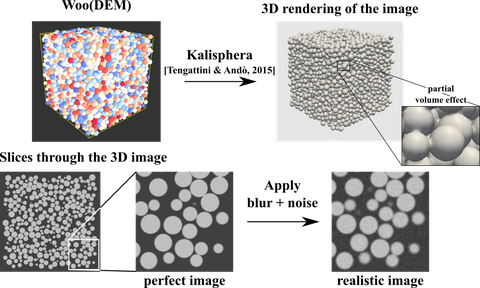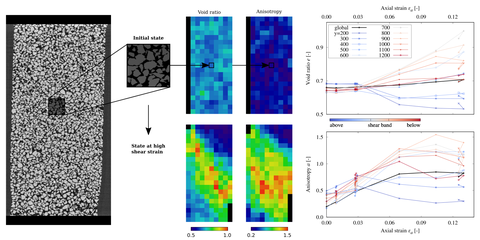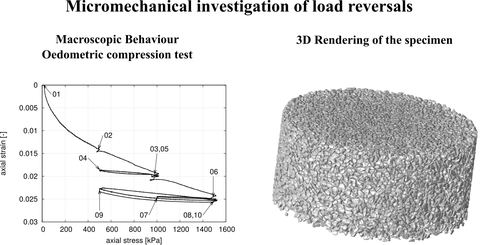Micromechanical analysis of the fabric of granular materials
The vast majority of constitutive models for soils is formulated in the framework of continuum. Their development has been based on observations of the so-called element tests in the laboratory. Herein, soil specimens are considered to be homogeneous and treated as continuum points characterized with single values of stress and strain tensors in a certain time instant of the measurements. Using these values as variables for the mathematical description of the soil behaviour, continuum constitutive models correspond to evolution equations for effective stress involving the strain related to the initial geometrical configuration of the specimen and the current strain rate.
To further features of advanced constitutive models belong inner variables, which are necessary for the description of e.g. anisotropy or recent deformation history. A specific example may be the inter- granular strain tensor, which controls the small strain stiffness of the granular materials. Most of inner variables are based on theoretical considerations. Experimental proofs and demonstrations are still missing.
A rapid evolution of optical methods in the experimental techniques opens the possibility for a better understanding of the soil behaviour in these tests. E.g. the X-ray tomography revealed impressively that the deformation state of the specimens in element tests is by no means homogeneous, even if external observation can suggest it. Thus, a better understanding of the link between the particulate soil nature and essential variables of the continuum models can be obtained from the analysis of the optical experimental techniques applied in element tests.
The direction of a loading has a significant influence on soil behaviour. One consequence of a change of the loading reversal is an abrupt change (and increase) of the macroscopic stiffness. This behaviour was investigated quite a lot in the past and it was discovered that the soil behaves nearly elastic in a specific range after the strain reversal, which is called the quasi-elastic range. The following question might be posed: Is this a purely macroscopic observation or does the grain assembly rearrange in a way that mimics elastic behaviour at the macro-scale?
This effect was investigated with discrete element (DEM) simulations, e.g by [O'Sullivan and Cui, 2009]. Although the authors main focus lay on the evolution of the contact force network, they discovered that the contact network during the reversal behaved relatively stable, the coordination number and the fabric changed only slightly and the grain displacements were ’elastic’. This means that the grains within the skeleton had almost the same positions before unloading and after reloading. Although this is only a strongly idealised simulation using assumptions on inter-particle relations and idealised particle shapes, it might be deduced that the result qualitatively holds for real soils as well.
Unfortunately, an experimental validation of these micromechanical observations is still missing. We are currently working on experiments carried out in the x-ray micro-tomograph to determine fabric changes during such load reversals and their link to the macroscopic phenomena.
X-ray micro-tomography enables us to obtain non-destructive full-field images (of the x-ray attenuation coefficient of the material) of the complete specimen. Thus, we can acquire images of a specimen at several stages of a macroscopic loading, such as isotropic, oedometric or triaxial compression tests.
These images can be exploited for different purposes:
- the kinematics of the specimen, e.g. displacements and strains, from one to the next recorded state
- the determination of the fabric, e.g. positions of grains and orientations of contacts and grains, at each recorded state
- and many others ...
Our analysis focuses on the determination of the fabric of granular materials, especially on the contact fabric. A rather thorough study on the metrology, revealed that due to the inherent properties of x-ray tomographies these measurements are far from trivial. When common tools are used for the image analysis, we found that contacts are systematically over-detected and a strong bias is introduced when determining the orientations. These issues have to be considered when quantitative measurements are the objective.

Common image analysis steps for tomographies of granular materials
There exist several numerical techniques to investigate the behaviour of granular materials, such as the discrete element method, the Lattice-Boltzmann approach or the contact dynamics method. We chose to work with the discrete element method, which basically simulates the interaction of elastic particles with spring-slider-damper contact models – these can however be very different from each other (linear elastic, Hertz contact, …) and incorporate different features.
We use DEM simulations mainly for the two different purposes:
-
to validate the image analysis tools we employ. For this reason, numerical specimen are created and loaded and synthetic images of these specimen are generated. These images have to resemble real images and as such exhibit their inherent features, such as noise, blur and the partial volume effect. Comparing the results from the analysis on the synthetic images and the reference from the numerical simulations then allows us to quantify the accuracy of the image analysis tools.

Creating realistic synthetic images from DEM simulations
-
to complement the results from the image analysis of the real experiments. In order to complement these results, similar, but simplified, simulations are run and numerically evaluated. The advantage of the simulations is, that we can access the whole spectrum of micromechanical entities, that for example includes inter-particle forces that cannot yet be measured directly from tests.

Macroscopic behaviour of a sphere packing in a DEM simulation
Laboratory tests, such as the triaxial test, are used to analyse the mechanical behaviour of soils. During those tests, we usually assume the soil sample to behave completely homogeneously and the stresses and strains measured at the boundaries to be representative of the whole sample. In reality, there is no homogeneity. Instead, we observe a localisation of the strains inside the sample in so-called shear bands.
In order to further analyse this heterogeneous behaviour, the microstructure of the soil is uncovered with the help of x-ray tomography. Individual regions of the sample can then be examined. The chosen size of these areas is of great importance in this regard: The analysed elements have to be representative! For this purpose, we developed a reliable procedure for the determination of the representative elementary volume depending on the chosen variable. With this representative volume, the soil sample can be examined regarding the following aspects:
- The heterogeneity of different variables can be characterised in selected states of the soil sample.
- The evolution of this heterogeneity can be analysed.
- The behaviour of chosen regions of the soil sample can be compared.

The evolution of the heterogeneity of a sand sample throughout a triaxial test. First published in: Schmidt et al., 2022, Granular Matter. https://doi.org/10.1007/s10035-022-01262-2

